Highlighting not only the Moon goddess Diana...

...but also the Aurora mass shooting this summer on the 43rd anniversary of the historic Moon landing (July 20). As discussed before, "Aurora" happens to be the name of a pregnant girl in Babylon A.D. who gives birth to messianic twin babies.

Michael Jackson is another famous "Moonwalker" whose birthday August 29 coincides with our second anchor date of the window.
Martian William
Time: August 28, 2012
Themes: Mars, British Royal Family (William)

Aug 28 will.i.am teams with NASA to debut song from Mars
William (will.i.am) and Mars.... Just days after Curiosity's interaction with the Martian "Coronation Stone." Basically implying "Coronation of Martian Prince William" or more archetypally the rebirth of the Jacobite "Grail" bloodline on the throne.
The very next day, or simultaneously on August 28-29, the birth (water breaking) event took place...
The Isaac Code
Time: ~August 26-29, 2012
Themes: British Royal Family (Kate), Birth, Apple
Right on "August 29"...
 Aug 26 Isaac Death Toll In Haiti Rises To 9
Aug 26 Isaac Death Toll In Haiti Rises To 9
Aug 26 Tropical Storm Isaac Should Rival Hurricane Katrina
Aug 27 Eerie similarities: Isaac follows track of Katrina
Aug 27 Isaac churns in Gulf along Katrina's path

Aug 28 Isaac makes landfall in southeastern Louisiana
Aug 28 Isaac hits US Gulf Coast, heads for New Orleans
Aug 29 Hurricane Isaac makes 2nd landfall
Aug 29 Storm surge overtops levee, 12-foot flood...

Aug 30 Dam Failure Feared After Tropical Storm Isaac
Everyone could see that Isaac was a Katrina clone, ravaging the same region on the same date, exactly 7 years later. An echo anticipated in Aurora Code 2012 (7/21/2012):
August 29 - Babylon A.D. release date - adds to the pregnancy/birth theme as it is the birthday of the ancient Egyptian goddess Hathor, associated with the Milky Way/Nile and the flood ("water breaking") and considered a herald of imminent birth.
In 2005, August 29 was the exact date of New Orleans' "water breaking" impact moment when Hurricane Katrina made landfall there... right at the midpoint of a Galactic-Mayan timeline directly involving the year 2012.
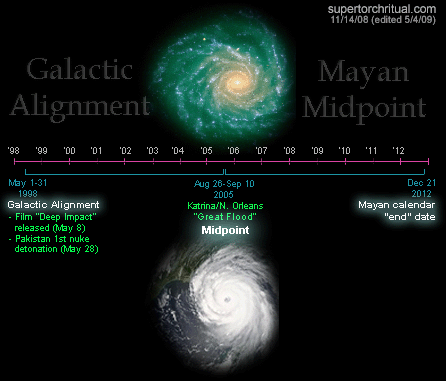
"Katrina" means "Catherine" as in Catherine"Kate" Middleton, i.e. the UK princess whose pregnancy/childbirth we've been long projecting for the Mayan window of 2012-2013 on our sites (Etemenanki/STRUG). [...]
"Maya" is today Mexico [as in "Gulf of Mexico"] and the name "Mexico" via Mextli refers to a "god of war" which in Roman mythology is Mars. "Mexico" via Mexihco means "Place at the Center of the Moon" implying "in the womb of Diana". [...]
...I'm going to go ahead and say that I see the latter part of August as a window for big things. Anchor dates ~August 24 and 29.
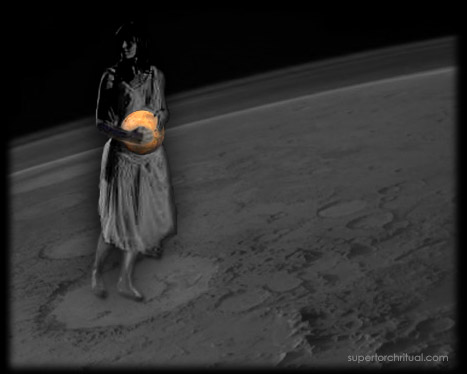
So we had the symbolism down beforehand and Isaac was a dramatic pattern fulfillment, the reality of which was confirmed and enhanced by additional eye-popping clues dropped on the other side of the Atlantic that same day...
It was the Paralympics opening ceremony in London on August 29 where Isaac Newton was being honored for his contribution to the expansion of human knowledge.
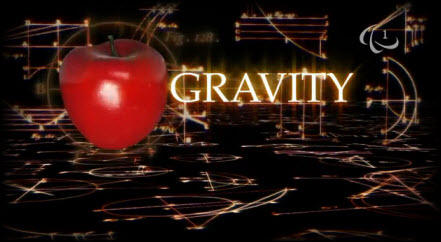
[Graphic from Paralympics opening ceremony]
Two Isaacs, same message. Isaac Newton is all about gravity and the (falling) apple, implying the following:
- "Gravity" is related to the Latin word gravidity (meaning "heavy") which is a scientific term for the state of pregnancy.
- "Apple" is the meaning of the term "Avalon" which is King Arthur's mythical "underworld" where he is said to be hibernating and would return from as the Once and Future King ("rebirth"), i.e. a drama unfolding at this time semi-literally through the rise of the Kate-William-baby trinity.

[Many apples during Paralympics opening ceremony]
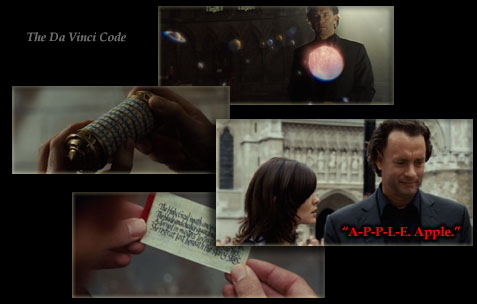
A big exclamation mark came toward the end of the show in the form of a giant naked, pregnant woman based on an actual sculpture in London called "Alison Lapper Pregnant". I'm not kidding, see for yourself:
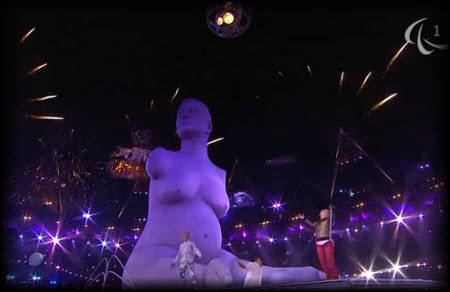
She was
the centerpiece of the
closing phase of the ceremony. For much of the duration of the show, however, the centerpiece was... the
Moon.
The
whole ceremony was
lunar, and it was in
London... together evoking
Princess Diana. In this way, we were given another confirmation that the prevalent pregnancy/birth motif pertains mainly (but not exclusively) to the late princess's Arthurian descendants/family/bloodline. Kate Middleton while not related by blood is a worthy successor to Diana and is more than ready to bring a new life into this world with Prince William. My projection has always been that she would likely get pregnant in 2012 and give birth in the 2012-2013 time frame (naturally looking at 2013 now).
We are talking "
Grail bloodline" here and there was a blatant foreshadowing in the form of NASA's
GRAIL twin probes
entering orbit around the
Moon right at the start of
2012 on
New Year's Eve/Day. "GRAIL" here stands for "
Gravity Recovery and Interior Laboratory".
As it happens
August 29 is
also New Year's Day ("1 Thoth") of the (Alexandrian) ancient Egyptian calendar. In ancient Egypt New Year's Day signified
rebirth via the combination of the heliacal rising of Sirius and the annual inundation ("water breaking") of the Nile.
Everything fits just beautifully. Pattern projected and fulfilled.
At this stage there should be no denying that the pattern is real.
Golden Apple
We can start looking
ahead using the same general pattern and specifically the
golden apple which was conspicuously floating around at the opening ceremony on August 29.

Thrown into a party, a golden apple becomes an unmistakable omen.... hinting at what amounts to a world war. Great chaos. That's the basic story of the Golden Apple of Discord in Greek mythology: goddess Discordia/Eris throws a golden apple with the inscription "for the fairest" into a wedding banquet, followed by a beauty contest, then the "abduction" of Helen as a direct consequence, sparking the Trojan War (ancient world war).
From my multicontextual point of view, it's no coincidence that the first impact event of 2012 was the Costa Concordia cruise ship disaster off Italy. "Concordia" is obviously the opposite (= upside down, like the wrecked ship) of "Discordia" (Eris) who threw the golden apple. Strong resonance there.
No coincidence especially if you take into account the fact that London was originally called "New Troy" according to legend...

...and the fact that soon after the Paralympics great chaos was unleashed in the world starting around 9/11 (= big chaos/war date) coinciding with another big "Apple" event (iPhone 5):


Orange Alignment
Time: ~October 20, 2012
Themes: Golden apple/Orange, Chaos, Birthquake
For many years now we've been tracking what we call the "Orange Alignment" i.e. a heliocentric lining up of Venus, Sun and Mercury. I've shown many times before that when they come, we do feel their impact. It is my view that the next one coming up soon is a highly charged one... because, for one, in many languages the fruit orange is called... "golden apple".


The Orange Alignment will be formed in our solar system on
~October 20, 2012, like this:
Making it even more ominous, the alignment angle pinpoints the Earth's orbital position on January 12-13 (annual), which is the exact date of this year's Costa Concordia disaster (= Discordia => golden apple/orange) as well as the devastating Haiti earthquake (Birthquake) back in 2010. (Orange Alignments are often "earth changes" markers.)

That, to me, just does not look good. Some kind of big impact appears to be in the offing there (directly or indirectly) and I would expect it to continue to express the same underlying themes, but more intensely. Hopefully it's more about things like the Royal Pregnancy, Mars, etc. rather than severe earth changes, war, and such. There are obviously many possible scenarios and we may well be looking at multiple events (or just strong signals) unfolding simultaneously or in quick sequence.
I should also mention that there are other aspects of the whole golden apple business that points its temporal finger squarely at the year 2013. As well, before we even get there we'll have... certain things coming later this year which we'll need to talk about soon.
Enough for now. Thanks for reading!
https://www.goroadachi.com/etemenanki/golden_apple.html 
